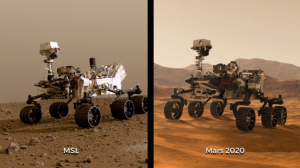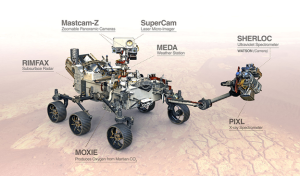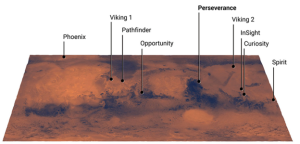MARS 2020 PERSEVERANCE ROVER

Source: NASA
The Mars 2020 Perseverance Rover shares design characteristics with the Mars Science Laboratory (MSL)’s Curiosity rover. Even with their similarities, the two rovers have different parts to play in Mars research activities.[1]
Mission
The goal for the Mars 2020 Perseverance Rover is to assist NASA by gathering information about the historical livability of Mars. This will be accomplished by searching for indications of former microbial life. The Mars 2020 Perseverance Rover gathers rock and soil samples by drilling. After collection, samples are saved in sealed tubes until a forthcoming mission that will transport them to Earth for study.[2]
The Mars 2020 Perseverance Rover is tasked with experimenting various technologies so humans will be prepared for exploration in the future. Ingenuity, the Mars helicopter, traveled to Mars with Perseverance, marking the inception of powered flight on Mars.[3]
The mission includes several different undertakings, such as finding resources, bettering landing approaches, and identifying conditions of the environment that could make an impact on astronauts residing and working on Mars in the future. A way of generating oxygen from the Martian atmosphere will also be tested.[4]
Science
Perseverance’s science objectives are focused on four themes: Geology, Astrobiology, Sample Caching, and Preparation for Humans.[5]
Geology
This scientific objective entails analysis of rocks and landscape at Jezero Crater. This subject of study will answer questions regarding the environment of historical life on Mars related to temperature, aridity, and overall hospitableness for past life.[6]
Scientists could see that Jezero Crater was once home to water from orbit. Clay minerals and carbonates were revealed during these observations. These minerals and carbonates can only be formed with the existence of water. Since carbonites are known to document climates well, these materials will be of great use for scientists. It is possible the age of discovered rocks could be identified by volcanic rock.[7]
Astrobiology
This objective will undergo astrobiology explorations of geologic materials found at Jezero Crater. First, the livability of an ancient environment will be determined. After areas categorized as historically habitable are found, materials of immense biosignature preservation capability will be pursued. Searches for indications of past life will be conducted utilizing the information gleaned from the first two steps in this objective. The information found through these explorations will be an indication of historically habitable locations in the crater.[8]
Sample Caching
Perseverance will be tasked with collecting the best samples that showcase the geologic variety of Jezero Crater. Sample context will be carefully recorded. Future planetary necessities are catered to in the event NASA returns the cached samples. Over the span of its mission, Perseverance will obtain 30 samples.[9]
Preparation for Humans
This science objective is focused on future sustainability for humans on Mars. In this thread, the goals are associated with getting ready for human exploration on this planet. Technologies for in-situ Resource Utilization will be demonstrated to facilitate propellant and consumable oxygen production that is derived from the Martian atmosphere. Atmospheric dust size and morphology will allow further comprehension of the ramifications on surface systems operations and human health. Global atmospheric models will be confirmed with surface weather measurements.[10]
Perseverance has engineering sensors enclosed in its heat shield and backshell which collected information on different aspects of the entry vehicle passage and drop to the surface of Mars. Data regarding aerothermal conditions, thermal protection system, and aerodynamic performance characteristics were collected.[11]
Rover Spacecraft
The Mars Science Laboratory's Curiosity rover configuration was the basis for the Mars 2020 Perseverance rover. Excluding the arm, the Mars 2020 Perseverance rover is around 10 feet long, 7 feet tall, and 9 feet wide. Perseverance weighs 2,260 pounds.[12]
Primary Instruments
The Perseverance rover carries seven primary instruments.

Source: NASA
Mastcam-Z is a state-of-the-art camera system with several different capabilities including zoom, panoramic and stereoscopic imaging capability, and the ability to aid scientists with appraising Martian surface mineralogy. This instrument is also helpful for rover operations.[13]
The Mars Environmental Dynamics Analyzer (MEDA) contains a group of sensors that produce measurements for:
- Temperature
- Wind speed and direction
- Pressure
- Relative humidity
- Dust size and shape[14]
- Mars Oxygen ISRU Experiment (MOXIE)
The Mars Oxygen ISRU Experiment (MOXIE) is an exploration technology tasked with creating oxygen using the carbon dioxide from Mars’ atmosphere.[15]
The Planetary Instrument for X-ray Lithochemistry (PIXL) is an X-ray fluorescence spectrometer. The spectrometer will identify the fine scale elemental composition of Mars’ surface materials with PIXL. PIXL allows for increased chemical element exposure and analysis.[16]
The Radar Imager for Mars’ Subsurface Experiment (RIMFAX) uses ground-penetrating technology for its subsurface geologic structure. This structure is provided at centimeter-scale resolution.[17]
This spectrometer is responsible for identifying fine-scale mineralogy and organic components. It uses an ultraviolet (UV) laser and fine-scale imaging and will be the first Ramen spectrometer that’s traveled to Mars’ surface.[18]
The SuperCam has the power to find existing organic compounds within rock and regolith without being close. SuperCam also has capability for mineralogy, imaging, and chemical composition analysis.[19]
Exploration Environment

Map of Mars showcasing the Perseverance landing site with respect to other Mars missions in the past.
Source: NASA
Jezero Crater was one of over 60 potential landing site locations in NASA’s selection process. This site was home to a lake formed from river channels over 3.5 billion years ago. It’s possible the crater was home to microbial life and evidence of this life may show up in remains from sediment captured from the lakebed or shoreline.[20]
Jezero Crater is found within the Western side of the Isidis Planitia flat plain. At 28 miles wide, the crater is around 2,300 miles away from the Gale Crater (the landing site of Curiosity).[21]
The CRISM instrument has unearthed the presence of clays in the crater that can only be formed with water. These clays have been discovered on Earth at the Mississippi river delta. Microbial life was found within rock at this site and illustrates the discovery potential for the Jezero Crater.[22]
Mission Team

Pictured are team members of the Mars 2020 Perseverance rover mission located at NASA’s Jet Propulsion Laboratory.
Source: NASA
Scientists and engineers belonging to various disciplines form the Mars 2020 Perseverance team. This mission boasts inclusion from countries and organizations worldwide, but the principal investigators of the science team are from Spain and Norway in addition to the U.S.[23]
Major team members:
Project Manager: Art Thompson
Deputy Project Manager: Rick Welch
Deputy for Operations & Anomalies: Steve Lee
Project Scientist: Ken Farley
Deputy Project Scientist: Katie Stack Morgan [24]
Mission Timeline
On July 30, 2020, at 4:50 a.m. PDT, Perseverance launched from Launch Complex 41 at Cape Canaveral Air Force Station in Florida. An Atlas V-541 rocket, courtesy of United Launch Alliance, launched Perseverance. This rocket is identical to the InSight and Curiosity launch rockets.[25]
The time frame for surface operations is a minimum of one year in Mars’ time (equivalent to around 687 days in Earth’s time). Different phases of this mission are:
- Pre-launch activities
- Launch
- Cruise
- Approach
- Entry, Descent, and Landing
- Instrument Checks and First Drive
- Surface Operations
Perseverance is currently in the surface operations phase of this mission.[26]
Recent News
As of October 2022, NASA reports a formal agreement with partner European Space Agency (ESA) to develop a sample tube depot close to the ancient river’s base, at “Three Forks.” While Perseverance is the main channel for transport of samples on the Mars Launch Vehicle, this location will be an alternative with identical samples. Perseverance has gathered 14 rock-core samples in its initial two science campaigns. In addition, it has gathered three witness tubes and an atmospheric sample.[27]
Beginning October 1, 2022, the Preliminary Design and Technology Completion Phase of the Mars Sample Return Program began. The following items will be prioritized in this phase:
- Completing technology development
- Engineering prototyping
- Assessments of software and heritage hardware
- Additional risk mitigation activities[28]
Updated November 2022 by Jackie Johnson

Comments are closed.